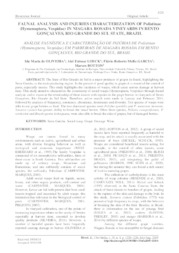Faunal analysis and injuries characterization of polistinae (hymenoptera, vespidae) in niagara rosada vineyards in Bento Gonçalves, Rio Grande do Sul state, Brazil.
Faunal analysis and injuries characterization of polistinae (hymenoptera, vespidae) in niagara rosada vineyards in Bento Gonçalves, Rio Grande do Sul state, Brazil.
Author(s): OLIVEIRA, I. M. de; LOECK, A. E.; GARCIA, F. R. M.; BOTTON, M.
Summary: The State of Rio Grande do Sul is a major producer of grapes in Brazil, highlighting the Serra Gaúcha as the main producing region. In the pursuit of good quality in grapes it is essential the control of pests, especially insects. This study highlights the incidence of wasps, which cause serious damage at harvest time. This study aimed to characterize the community of social wasps (Hymenoptera, Vespidae) through faunal analysis and to examine the relationship of these insects with injuries to the grape berries in vineya rds of Bento Gonçalves, Rio Grande do Sul State. Therefore, active search were made in January and February 2014, followed by analysis of frequency, constancy, abundance, dominance and diversity. Ten species of wasps were able to use grape berries as food. The two dominant species were Polybia ignobilis and P. minarum, however, Synoeca cyanea has greater ability to break the intact berries. Other three species, Polistes cavapytiformis, P. versicolor and Brachygastra lecheguana, were also able to break he skin of grapes, but of damaged berries.
Publication year: 2019
Types of publication: Journal article
Unit: Embrapa Grape & Wine
Keywords: Damage, Grapes, Serra Gaúcha, Social wasp, Wines
Observation
Some of Embrapa's publications are published as ePub files. To read them, use or download one of the following free software options to your computer or mobile device. Android: Google Play Books; IOS: iBooks; Windows and Linux: Calibre.
Access other publications
Access the Agricultural Research Database (BDPA) to consult Embrapa's full library collection and records.
Visit Embrapa Bookstore to purchase books and other publications sold by Embrapa.

